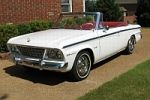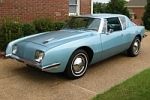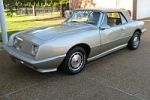I posted on this some time back, but with new information, I thought I'd just kick off a new discussion.
The '63 overheats (or rides the "H" line) without much rhyme or reason. Initially I suspected maybe a bad ground, but I've been cleaning up dash wiring in recent days, and everything seems to be grounded just fine. I haven't checked the temp of the water with a meat/candy thermometer as was suggested last time yet, primarily because it's not something that manifests itself regularly enough that you can start the car and know it's going to happen.
Here's the weird part though. Whenever the car starts riding the redline on heat, if I open the heater core up and divert the flow through there, it cools down to normal reasonably quickly. Initially I would drive like that, with the heat slowly broiling me as I drove, but one day I was on a long drive on the Interstate and the car started heading towards overheating. I opened the slider, and closed it as the engine was just beginning to cool off. For whatever reason, the engine not only continued to cool to the normal zone, it stayed cool for the next 20 minutes on the interstate going 60 mph all the way to my destination. After that experience, any time it starts to overheat, I open the heat slider, slide it shut as soon at the temperature starts moving, and it's the same thing. It cools off, and stays cool.
My theory is that something of a significant size is blocking water flow, maybe at the return prior to getting pumped into the radiator, and getting caught somewhere due to suction pinning it in the channel. When I open the heater core, the change in water pressure eliminates the suction enough that the piece falls or moves or whatever, and the water can once again flow freely. Does that sound realistic? If so, where do I start looking for this blockage? Do I pop the block plugs out, or remove the water manifold, or where would I begin? Or am I totally off my rocker, and this is possibly something else entirely?
Any ideas appreciated. Thanks!
The '63 overheats (or rides the "H" line) without much rhyme or reason. Initially I suspected maybe a bad ground, but I've been cleaning up dash wiring in recent days, and everything seems to be grounded just fine. I haven't checked the temp of the water with a meat/candy thermometer as was suggested last time yet, primarily because it's not something that manifests itself regularly enough that you can start the car and know it's going to happen.
Here's the weird part though. Whenever the car starts riding the redline on heat, if I open the heater core up and divert the flow through there, it cools down to normal reasonably quickly. Initially I would drive like that, with the heat slowly broiling me as I drove, but one day I was on a long drive on the Interstate and the car started heading towards overheating. I opened the slider, and closed it as the engine was just beginning to cool off. For whatever reason, the engine not only continued to cool to the normal zone, it stayed cool for the next 20 minutes on the interstate going 60 mph all the way to my destination. After that experience, any time it starts to overheat, I open the heat slider, slide it shut as soon at the temperature starts moving, and it's the same thing. It cools off, and stays cool.
My theory is that something of a significant size is blocking water flow, maybe at the return prior to getting pumped into the radiator, and getting caught somewhere due to suction pinning it in the channel. When I open the heater core, the change in water pressure eliminates the suction enough that the piece falls or moves or whatever, and the water can once again flow freely. Does that sound realistic? If so, where do I start looking for this blockage? Do I pop the block plugs out, or remove the water manifold, or where would I begin? Or am I totally off my rocker, and this is possibly something else entirely?
Any ideas appreciated. Thanks!






Comment